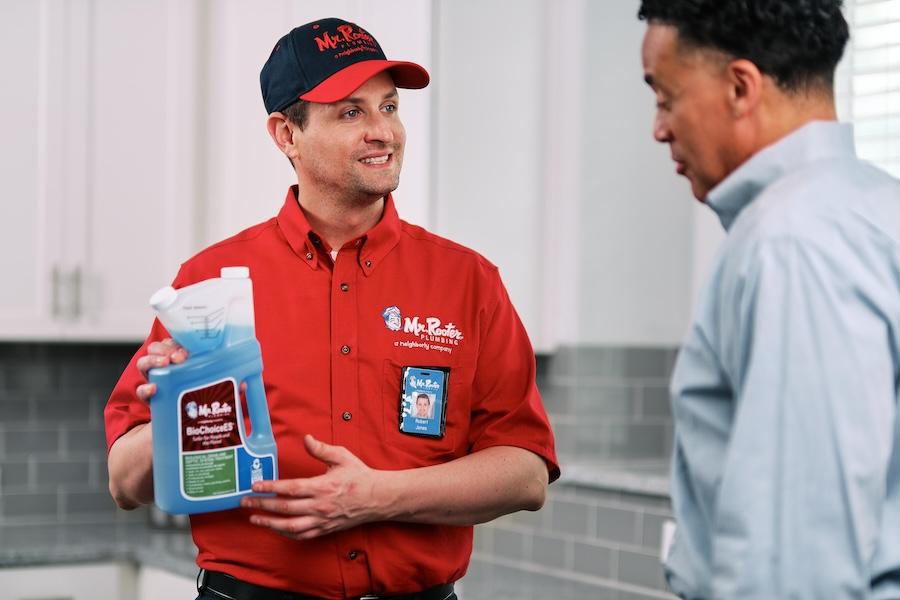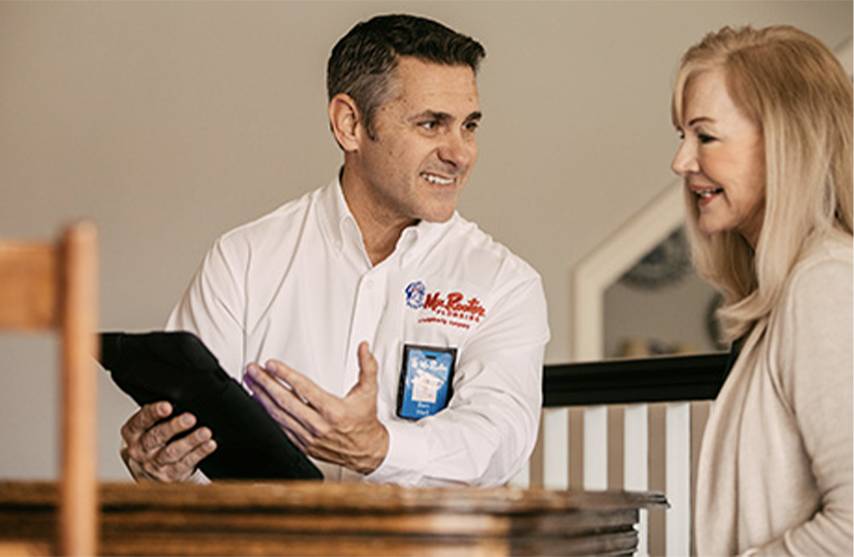
Whether you’re prepping dinner or cleaning up, standing water in the sink creates an instant problem. If you're like many homeowners, you may be tempted to grab a bottle of drain cleaner and hope it works, but those harsh chemicals can damage your pipes, and they only provide a temporary fix. Mr. Rooter Plumbing can help. Thankfully, there are safe ways to clear a clog without compromising your plumbing system.
This method is as simple as it sounds, but don’t underestimate its effectiveness. Hot water works well on grease and soap residue, which is the kind of buildup that lines the inside of your kitchen pipes and causes slow drains. Start by removing any standing water in the sink. Then boil a full kettle or pot of water. Wait for it to cool slightly, then slowly pour it down the drain in stages to give the water time to work through any soft clogs. Wait a few minutes between pours and listen for signs that the water is draining more freely. This can sometimes be enough to fix the issue, especially if you catch the clog early. If the sink backs up again soon after, it’s probably a sign of a deeper blockage.
This method works best when the clog is caused by food particles, grease, or organic matter. It's completely safe for your plumbing and doesn’t require anything more than what you probably have in your kitchen. First, you'll need to pour half a cup of baking soda down the drain. Use a spoon or small spatula if needed to get it past the drain cover. Then slowly pour a cup of white vinegar into the drain. The mixture will fizz. This is what helps loosen buildup. Cover the drain with a plug or a small plate to keep the reaction focused inside the pipe. Let it sit for 15 to 30 minutes. While you wait, boil a pot of water. After the time is up, pour the hot water slowly into the drain to flush out any loosened debris. This process can clear out small blockages and freshen the drain at the same time. If the water still drains slowly, repeat the process once more before moving to mechanical methods.
Sink plungers are different from toilet plungers. They have a flat bottom which creates a better seal over the kitchen drain. If your sink has a double basin, make sure to seal off the other side using a wet cloth or a drain stopper. This helps create the pressure you need for plunging to work. Fill the clogged side with enough water to cover the bottom of the plunger cup. Position the plunger over the drain and push down firmly, then pull up quickly without lifting the seal. Repeat this motion several times in a row, about 10 to 15 pumps. You may hear the clog break loose, or notice the water suddenly draining faster. That’s a sign you’re making progress. Run hot water from the faucet for a minute afterward to flush any remaining particles. If plunging doesn’t work after several tries, you’ll likely need to physically remove the blockage using a more direct method.

If you’re comfortable working under the sink, this is usually the most effective way to get rid of a stubborn clog. The P-trap is the curved section of pipe beneath the sink that catches food scraps, grease, or small objects. Before you begin, turn off the water supply to your sink and then place a bucket underneath the pipe to catch any water or debris. Use channel lock pliers or your hands to loosen the slip nuts on the side of the trap. Carefully remove the trap and dump its contents into the bucket. Inspect it for buildup or obstructions. Use a bottle brush or a straightened wire hanger to clean it, then reattach the trap and tighten the fittings securely. Turn on the faucet and check for leaks. Let the water run for a full minute to confirm the drain is clear. If the clog is deeper in the line and not in the trap, you may need to use a drain snake or auger, or call a professional plumber who can remove the blockage without damaging your system.
If you’ve tried all of the above and the sink is still draining slowly or backing up, the problem may be in the main drain line. At that point, calling for a plumbing repair service is the best solution. Repeated DIY attempts can make things worse if the blockage is lodged far down the pipe or involves tree roots, mineral deposits, or collapsed sections of pipe. A plumber in Howland Corners can use a camera inspection to locate the issue and determine the right fix. Professional tools like motorized augers or hydro jetting systems can clear the toughest clogs safely and quickly. If you're also dealing with slow drains in other parts of the house, it’s possible you have a larger issue. Ignoring chronic drain problems can lead to water damage, corrosion, and expensive repairs. A plumbing repair service will make sure your system is restored without unnecessary delays or added complications. Sometimes the most cost-effective option is the one that protects your entire plumbing system long-term.
Clogged sinks can disrupt your day and leave you guessing about what’s really going on inside your pipes. Trying to solve the problem without harsh chemicals is the better choice for your home’s plumbing and the environment. Simple tools and household ingredients can handle many clogs, but when the problem persists, it’s time to call a plumber who can resolve the issue for good. Mr. Rooter Plumbing is ready to help with everything from a faucet repair to emergency drain issues. If your kitchen sink won’t drain or you’re tired of repeated clogs, don’t wait for a bigger problem to develop. Call today to schedule a visit with a trusted plumber in your area.